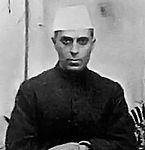
The Partition of India was the division of British India in 1947 which eventually accompanied the creation of two independent dominions, India and Pakistan. The Dominion of India became, as of 1950, the Republic of India (India), and the Dominion of Pakistan became, as of 1956, the Islamic Republic of Pakistan (Pakistan) In 1971, the People's Republic of Bangladesh (Bangladesh) came into being after Bangladesh Liberation War. The partition involved the division of three provinces, Assam, Bengal and Punjab, based on district-wide Hindu or Muslim majorities. The boundary demarcating India and Pakistan came to be known as the Radcliffe Line. It also involved the division of the British Indian Army, the Royal Indian Navy, the Indian Civil Service, the railways, and the central treasury, between the two new dominions. The partition was set forth in the Indian Independence Act 1947 and resulted in the dissolution of the British Raj, as the British government there was called. The two self-governing countries of Pakistan and India legally came into existence at midnight on 14–15 August 1947.
Events in the year 1937 in India.

The Pakistan Movement or Tehrik-e-Pakistan was a religious political movement in the 1940s that aimed for and succeeded in the creation of Pakistan from the Muslim-majority areas of the British Indian Empire.

The Indian Councils Act 1909, commonly known as the Morley-Minto or Minto-Morley Reforms, was an Act of the Parliament of the United Kingdom that brought about a limited increase in the involvement of Indians in the governance of British India.
The Cripps Mission was a failed attempt in late March 1942 by the British government to secure full Indian cooperation and support for their efforts in World War II. The mission was headed by a senior minister Sir Stafford Cripps, Lord Privy Seal and leader of the House of Commons. Cripps belonged to the left-wing Labour Party, traditionally sympathetic to Indian self-rule, but was also a member of the coalition War Cabinet led by the Prime Minister Winston Churchill, who had long been the leader of the movement to block Indian independence.
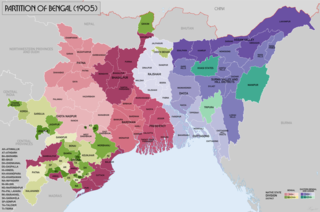
The decision to effect the Partition of Bengal was announced on 19 July 1905 by the Viceroy of India, Curzon. The partition took place on 16 October 1905 and separated the largely Muslim eastern areas from the largely Hindu western areas. The Hindus of West Bengal who dominated Bengal's business and rural life complained that the division would make them a minority in a province that would incorporate the province of Bihar and Orissa. Hindus were outraged at what they saw as a "divide and rule" policy, even though Curzon stressed it would produce administrative efficiency. The partition animated the Muslims to form their own national organization on communal lines. In order to appease Bengali sentiment, Bengal was reunited by Lord Hardinge in 1911, in response to the Swadeshi movement's riots in protest against the policy and the growing belief among Hindus that east Bengal would have its own courts and policies.
The Cabinet Mission of 1946 came to India aimed to discuss the transfer of power from the British government to the Indian leadership, with the aim of preserving India's unity and granting it independence. Formulated at the initiative of Clement Attlee, the Prime Minister of the United Kingdom, the mission had Lord Pethick-Lawrence, the Secretary of State for India, Sir Stafford Cripps, President of the Board of Trade, and A. V. Alexander, the First Lord of the Admiralty. Lord Wavell, the Viceroy of India, did not participate in every .step but was present.it was divided into three groups A,B,C clusters.
"Day of Deliverance" was a celebration day marked by Muslim League and others on 22 December 1939 during the Indian Independence movement. It was led by Muslim League President Muhammad Ali Jinnah, and intended to rejoice the resignation of all members of the rival Congress party from provincial and central offices in protest over their not having been consulted over the decision to enter World War II alongside Great Britain.

The history of the British Raj refers to the period of British rule on the Indian subcontinent between 1858 and 1947. The system of governance was instituted in 1858 when the rule of the East India Company was transferred to the Crown in the person of Queen Victoria. It lasted until 1947, when the British provinces of India were partitioned into two sovereign dominion states: the Dominion of India and the Dominion of Pakistan, leaving the princely states to choose between them. The two new dominions later became the Republic of India and the Islamic Republic of Pakistan. The province of Burma in the eastern region of the Indian Empire had been made a separate colony in 1937 and became independent in 1948.
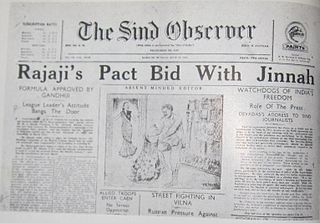
C. Rajagopalachari's formula was a proposal formulated by Chakravarti Rajagopalachari to solve the political deadlock between the All India Muslim League and the Indian National Congress on the independence of British India. The League's position was that the Muslims and Hindus of British India were of two separate nations and hence the Muslims had the right to their own nation. The Congress, which included both Hindu and Muslim members, was opposed to the idea of partitioning India. With the advent of the Second World War the British administration required both parties to agree so that Indian help could be sought for the war effort.
When the All-India Muslim League was founded at Dacca, on 30 December 1906 at the occasion of the annual All India Muhammadan Educational Conference, It was participated by the Muslim leaders from Punjab, i.e., Sir Mian Muhammad Shafi, Mian Fazl-i-Hussain, Abdul Aziz, Khawaja Yusuf Shah and Sh. Ghulam Sadiq. Earlier Mian Muhammad Shafi organised a Muslim Association in early 1906, but when the All-India Muslim League was formed, he established its powerful branch in the Punjab of which he became the general secretary. Shah Din was elected as its first President. This branch, organised in November 1907, was known as the Punjab Provincial Muslim League.
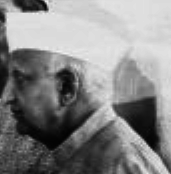
General elections were held in British India in 1934. The Indian National Congress emerged as the largest party in the Central Legislative Assembly.
During the Partition of India, violence against women was an extensive issue. It is estimated that during the partition between 75,000 and 100,000 women were kidnapped and raped. The rape of women by males during this period is well documented, with women also being complicit in these attacks.

Muhammad Ali Jinnah was a lawyer, politician and the founder of Pakistan. Jinnah served as the leader of the All-India Muslim League from 1913 until Pakistan's independence on 14 August 1947, and then as Pakistan's first Governor-General until his death. He is revered in Pakistan as Quaid-i-Azam and Baba-i-Qaum, "Father of the Nation"). His birthday is considered a national holiday in Pakistan.
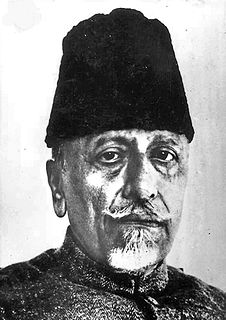
Provincial elections were held in British India in January 1946 to elect members of the legislative councils of British Indian provinces. The consummation of British rule in India were the 1945/1946 elections. As minor political parties were eliminated the political scene became restricted to the Indian National Congress and the Muslim League who were more antagonised than ever. The Congress, in a repeat of the 1937 elections, won 90 percent of the general non-Muslim seats while the Muslim League won the majority of Muslim seats in the provinces. The League verified its claim to be the sole representative of Muslim India. The election laid the path to Pakistan.

The Bengal Legislative Assembly was the largest legislature in British India, serving as the lower chamber of the legislature of Bengal. It was established under the Government of India Act, 1935. The assembly played an important role in the final decade of undivided Bengal. The Leader of the House was the Prime Minister of Bengal. The assembly's lifespan covered the anti-feudal movement of the Krishak Praja Party, the period of World War II, the Lahore Resolution, the Quit India movement, suggestions for a United Bengal and the partition of Bengal and partition of British India.
The Bengal Provincial Muslim League (BPML) was the branch of the All India Muslim League in the British Indian province of Bengal. It was established in Dacca on 2 March 1912. Its official language was Bengali. The party played an important role in the Bengal Legislative Council and in the Bengal Legislative Assembly, where two of the Prime Ministers of Bengal were from the party. It was vital to the creation of the Dominion of Pakistan, particularly after its election victory in 1946.

Islam is the second-largest religion in South Asia with about 600 million Muslims, forming about one-third of South Asia's population. South Asia has the largest population of Muslims in the world, with about one-third of all Muslims being from South Asia. Islam first came to South Asia to coastal Malabar through Arab traders as early as the 7th century CE. The Cheraman Juma Masjid in Kerala is thought to be the first mosque in India, built in 629 CE by Malik ibn Dinar.







